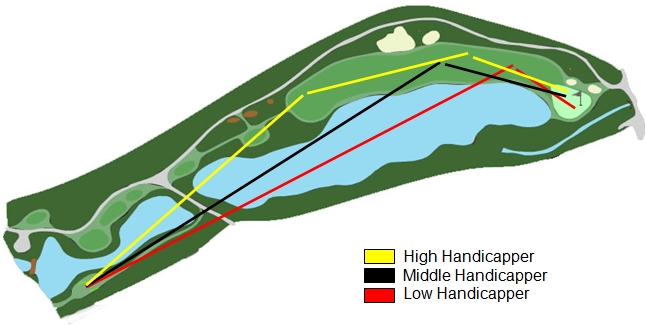How To Manage The Golf Course
If you’re playing a course you know well then you should have a general plan/strategy for each hole. Of course the same is true for other golf courses, but if you have never played a course before then it’s very tough to do that. You’re just guessing. That’s a big reason why golf pro’s play practice rounds before an event. And that’s why experience on a golf course counts a lot.
But all too often I see golfers make simple course management mistakes on their home course. The main reason is because golfers don’t take into account their ability to hit certain shots.
When you make a plan/strategy for a golf hole it should take into account your ability to hit shots. If you are planning to hit a shot that you’re not confident about, this will translate into a tentative stroke. And tentative strokes NEVER produce good golf shots.
So when you’re planning your strategy on a hole you should figure out the easiest and safest route to the hole. And when considering your approach for a tee shot and hole you need to think about the risks on each hole. For example, here is a good guide as to the weighting of potential risks in order:
1. Out-of-bounds
2. Water
3. Unplayable lie
4. Deep pot bunker
5. Heavy rough
6. Severe ground slope
7. Shallow, low lipped bunker
8. Light rough
9. Slight ground slope
10 Severe slope on green
A lot of golfers never think about where they are trying to hit the ball on the green. Or exactly what portion of the green, to be precise. Many times it would be better to be 30 feet short of a pin and putting straight uphill, rather than 15 feet above the hole. Particularly if the greens are fast. When planning your hole strategy you MUST take into account where on the green you would like to be and where you absolutely must not be.
Having said all of that, your plan/strategy should not be set in concrete. You should allow yourself the ability to change your plan at any given time on the golf course, because on the golf course things change.
For example, the wind may be blowing a certain way making a certain shot you’ve planned very hard to execute. Or you may be hitting your driver extremely well and you feel confident on a hole to hit a driver where you’ve planned to hit an iron off the tee.
You may be striking your irons very well and want to attack a pin that is very near a big slope on the green.
So have a general strategy for each hole, e.g. you’re going to play conservatively off a tee by taking an iron etc. But realize that you’re free to change that strategy as you’re playing. It’s better to have a plan/strategy which you change, than it is to have no plan or strategy at all.
Now below is an example of how golfers of different abilities may plan to play a hole. So look at this to get an idea on how you should plan to play each of the holes on your home course. And then go through each hole on your home course and plot your way around the course in the safest and easiest way possible.

Remember, when you’re doing this, do the greens as well. Pick the spots where you would like to be putting from. And if you have some greens which are very difficult to two putt from, then mark that on your plan.
| Important Note: The hole above shows a good example of how you can plan out your strategy on a hole, but on the day your plan may have to change. For example, the line the low handicapper has chosen would probably account for no wind. And if there is a strong head wind they will then have to change their plan and choose the middle handicapper route or even a line more conservative than that. So planning is important but you do have to be flexible. |
